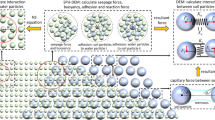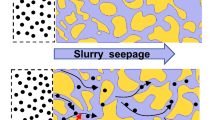Abstract
Mass transport and residence time of saline water from road salt applications in soil columns composed of Toyoura sand and weathered granite sand were investigated by simulations and in laboratory experiments. Both are sands found in Japan, especially the weathered granite sand. The Toyoura sand has a fairly uniform particle size of 0.1 to 0.4 mm diameter, and a saturated hydraulic conductivity Ks = 0.0296 cm/s, while the weathered granite sand used consisted of 13% fine materials (silt and clay) and 87% coarse materials (sand and gravel) with a saturated hydraulic conductivity Ks = 0.00393 cm/s. A model was developed to simulate rinsing of brine from a soil column. Assuming a steady, homogeneous flow induced by rainwater infiltration into the soil column, the model was found to match the experimental results for Toyoura sand very well. The normalized salt concentration in the effluent from the 40 cm tall soil column remained constant until about t = 500 s; the concentration then decreased with time quickly and, finally, approached zero. For the weathered granite sand, however, the salt concentrations in the effluent simulated by the model with assumption of homogeneous flow are inconsistent with the experimental data collected. A substantial delay occurs in mass transport of salt from the column, which is different from the Toyoura sand. The delay is attributed to shifts in “active” and “inactive pores” created in the soil due to fine particles such as silt and clay. The proportion of “active pores” and “inactive pores” is not constant but variable with time due to physical and/or electrochemical processes such as pore-size distributions and salt depletion in the soil. A modified model presented, using a time-variable active pore parameter k(t), can reproduce the experimental results for salt mass left in the soil better.











Similar content being viewed by others
Abbreviations
- C :
-
concentration of salt (gcm˗3)
- D yy :
-
dispersion coefficient (cm2 s˗1)
- g :
-
gravitational acceleration (9.8 ms˗2)
- K e :
-
effective hydraulic conductivity (cms˗1)
- K s :
-
saturated hydraulic conductivity (cms˗1)
- h :
-
piezometric head (cm)
- k :
-
pore activity parameter
- k ∞ :
-
the terminal value of k
- l :
-
the constant (= 0.5)
- L :
-
soil depth (cm)
- m :
-
the constant
- n :
-
the constant
- p :
-
pressure (Nm˗2)
- S :
-
salt concentration trapped in inactive pores (gcm˗3)
- t :
-
time (hour)
- v :
-
velocity of pore water flow (cms˗1)
- y :
-
vertical coordinate (cm)
- α:
-
the constant
- θ:
-
water content
- θr :
-
residual water content
- θs :
-
water content at saturation
- ρ :
-
fluid (water) density (gcm˗3)
- Ψ:
-
pressure head (suction) (cm)
- λ :
-
nondimensional time constant
References
Andrews, W. J., Stark, J. R., Fong, A. L., & Fallon, J. D. (2005). Water quality assessment of part of the Upper Mississippi River Basin, Minnesota and Wisconsin: Water quality along a flow system in the Twin Cities metropolitan area, Minnesota 1997 – 98. U.S. Geol. Survey Water Resources Investigation Rep, 2005–5120.
Baldocchi, D. D., Xu, L., & Kiang, N. (2004). How plant functional-type, weather, seasonal drought, and soil physical properties alter water and energy fluxes of an oak-grass savanna and an annual grassland. Agricultural and Forest Meteorology, 123, 13–39.
Brooks, R. H., & Corey, A. T. (1964). Hydraulic properties of porous media: hydrology papers. Colorado State University, 24 pp.
Chapra, S. C., & Canale, R. P. (1988). Numerical methods for engineers. New York, NY: McGraw-Hill.
Cortis, C., & Montaldo, N. (2013). A new ecohydrological model based on Richard equation. Procedia Environmental Sciences, 19, 67–76.
Environment Canada Health Canada. (1999). Canadian Environment Protection Act (CEPA) 1999, Priority substances list assessment report - Road salt. Canada: Ottawa.
Fong, A. (2000). Water-quality assessment of part of the Upper Mississippi River Basin, Minnesota and Wisconsin: ground-water quality in three different land-use areas 1996 – 1998. U.S. Geol. Survey Water Resources Investigation 00-4131.
Gillis, P. L. (2011). Assessing the toxicity of sodium chloride to the glochidia of freshwater mussels: implications for salinization of surface waters. Environmental Pollution, 159, 1702–1708.
Godwin, K. S., Hafner, S. D., & Buff, M. F. (2003). Long-term trends in sodium and chloride in the Mohawk River, New York: the effect of fifty years of road-salt application. Environmental Pollution, 124, 273–281. https://doi.org/10.1016/S0269-7491(02)00481-5.
Higashino, M., & Stefan, H. G. (2019). Rinsing of saline water after frequent road salt application from an unsaturated sandy soil by rainwater infiltration: significance of rainfall duration. Journal of Irrigation and Drainage Engineering, ASCE, 145(5). https://doi.org/10.1061/(ASCE)IR.1943-4774.0001385.
Higashino, M., Erickson, A. J., Toledo-Cossu, F. L., Beauvais, S. W., & Stefan, H. G. (2017). Rinsing of saline water from road salt is a sandy soil by infiltrating rainfall: experiments, simulations, and implications. Water, Air, and Soil Pollution, 228, 80. https://doi.org/10.1007/s11270-017-3256-1.
Jones, P. H., & Jeffrey, B. A. (1992). Environmental impact of road salting. In F. M. D’Itri (Ed.), Chemical Deicers and the Environment (pp. 1–91). Boca Raton: Lewis.
Kaushal, S. S., Groffman, P. M., Likens, G. E., Belt, K. T., Stack, W. P., Kelly, V. R., Band, L. E., & Fisher, G. T. (2005). Increased salinization of fresh water in the northeastern United States. Proceedings of the National Academy of Sciences of the United States of America, 102(13), 517–13,520. https://doi.org/10.1073/pnas.0506414102.
Kelly, V. R., Lovett, G. M., Weathers, K. C., Findlay, S. E. G., Strayer, D. L., Burns, D. J., & Liken, G. E. (2008). Long-term sodium chloride retention in a rural watershed: legacy effects of road salt on stream water concentration. Environmental Science & Technology, 42, 410–415. https://doi.org/10.1021/es071391l.
Lofgren, S. (2001). The chemical effects of deicing salt on soil and stream water of five catchments in southeast Sweden. Water, Air, and Soil Pollution, 130, 863–868. https://doi.org/10.1023/A:1013895215558.
Lord, B. N. (1989). Program to reduce deicing chemical use. In L. A. Roesner, B. Urbonas, & M. B. Sonnen (Eds.), Design of urban runoff quality controls. Proceedings Engineering Foundation Conference (pp. 421–435). New York, NY.
Marsalek, J. (2003). Road salts in urban stormwater: an emerging issue in stormwater management in cold climates. Water Science and Technology, 48, 61–70.
Montaldo, N., Rondena, R., Albertson, J. D., & Mancini, M. (2005). Modeling of vegetation dynamics for ecohydrologic studies of water-limited ecosystem. Water Resources Research, 41(10), W10416. https://doi.org/10.1029/2005WR004094.
Mualem, Y. (1976). A new model for predicting the hydraulic conductivity of unsaturated porous media. Water Resources Research, 12, 513–522.
Novotny, V., Smith, D. W., Kuemmel, D. A., Mastriano, J., and Bartosova, A. (1999). Urban and highway snowmelt: minimizing the impact on receiving water, Rep. Pr. 94-IRM-2, Alexandria, VA: Water Environ. Research Found.
Ramakrishna, D. M., & Viraraghocan, T. (2005). Environmental impact of chemical deicers - A review. Water, Air, and Soil Pollution, 166, 49–63.
Richards, L. A. (1931). Capillary condition of liquids through porous mediums. Physics, 1(5), 318–333.
Sako, K., Danjo, T., Fukagawa, R. and Bui, H. H. (2011a). Measurement of pore-water and pore-air pressure in unsaturated soil. Proc. of the 5th Asia-Pacific Conference on Unsaturated Soils, pp.443-448.
Sako, K., Danjo, T., Bui, H. H. and Fukagawa, R. (2011b). Behavior of pore-water and pore-air pressure in unsaturated soil using laboratory soil tank experiments, The 2nd Japan-Korea Joint Workshop on Unsaturated Soils and Ground, JW-Fukuoka, pp. 31-48.
Šimůnek, J., van Genuchten, M. Th., and M. Šejna (2005). The Hydrus-1D software package for simulating the one-dimensional movement of water, heat, and multiple solutes in variably-saturated media. Version 3.0, HYDRUS Software Series 1, Department of Environmental Sciences, University of California Riverside, Riverside, CA, 270 pp.
Šimůnek, J., Šejna, M., Saito, H., Sakai, M., & van Genuchten, M. T. (2013). The Hydrus-1D Software Package for Simulating the Movement of Water, Heat, and Multiple Solutes in Variably Saturated Media, Version 4.17, HYDRUS Software Series 3 (p. 342). Riverside: Department of Environmental Sciences, University of California Riverside.
Thunquist, E. L. (2004). Regional increase of mean annual chloride concentration in water due to the application of deicing salt. Sci. Total Environment, 325, 29–37. https://doi.org/10.1016/j.scitotenv.2003.11.020.
van Genuchten, M. T. (1980). A closed-form equation for predicting the hydraulic conductivity of unsaturated soils. Soil Science Society of America Journal, 44, 892–898.
van Genuchten, M. T., Leij, F. J., & Yates, S. R. (1991). The RETC code for quantifying the hydraulic functions of unsaturated soils, Report No. EPA/600/2-91/065, R.S. Kerr Environmental Research Laboratory, U.S. Ada, OK: Environmental Protection Agency.
Williams, C. A., & Albertson, J. D. (2004). Soil moisture controls on canopy-scale water and carbon fluxes in an African savanna. Water Resources Research, 40(9), W09302.
Acknowledgments
This work was supported by the Japan Society for the Promotion of Science Grant-in-Aid for Scientific Research (No. 18 K04376). The authors are grateful to this organization for the support.
Author information
Authors and Affiliations
Corresponding author
Additional information
Publisher’s Note
Springer Nature remains neutral with regard to jurisdictional claims in published maps and institutional affiliations.
Rights and permissions
About this article
Cite this article
Higashino, M., Stefan, H.G. & Aso, D. Removal of Saline Water due to Road Salt Applications from Columns of Two Types of Sand by Rainwater Infiltration: Laboratory Experiments and Model Simulations. Water Air Soil Pollut 230, 305 (2019). https://doi.org/10.1007/s11270-019-4337-0
Received:
Accepted:
Published:
DOI: https://doi.org/10.1007/s11270-019-4337-0




